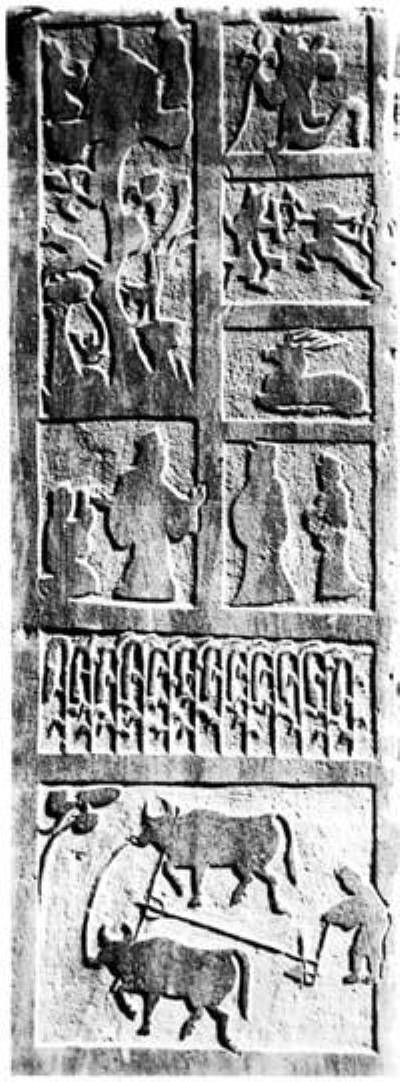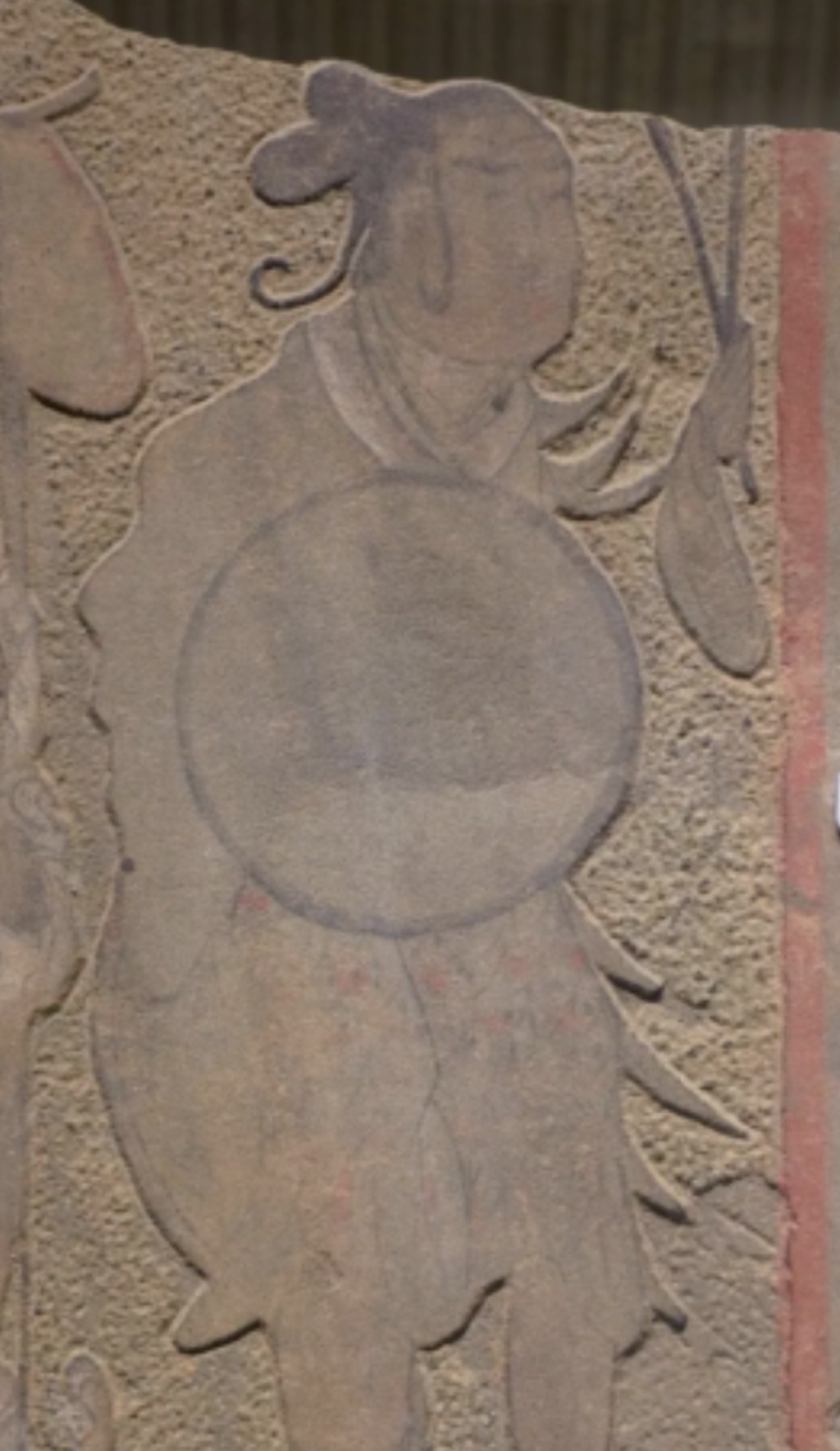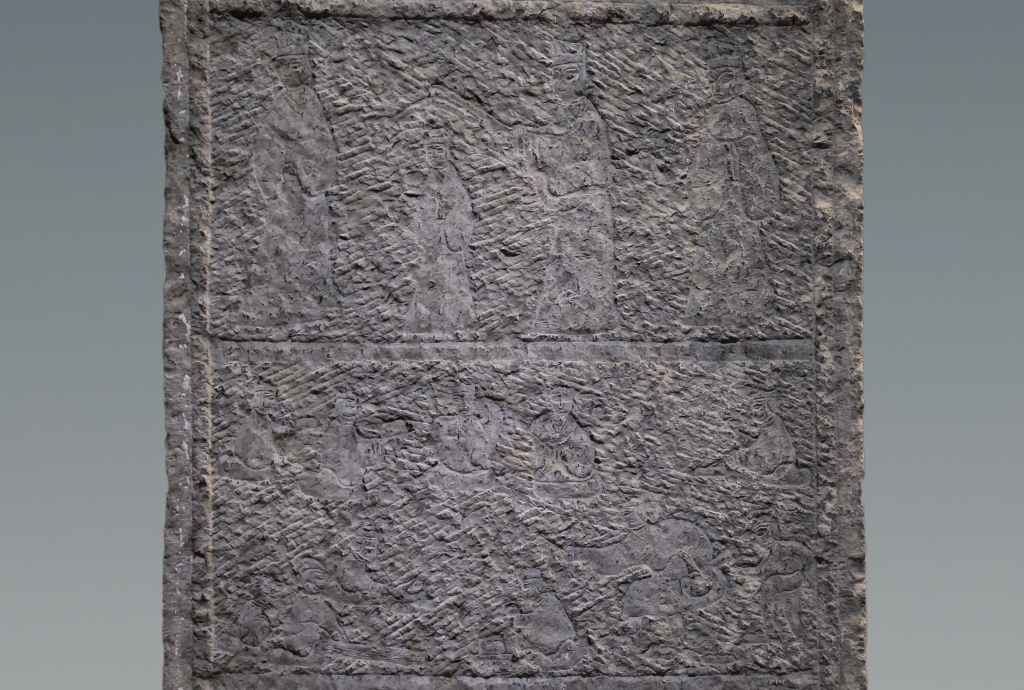
Grain in Ear is a solar term that carries the fragrance of soil and wheat. As the saying goes, "Busy planting during Grain in Ear" and "Busy planting late rice seedlings". When the cuckoo's cry passes over the fields, countless folk artists have, for thousands of years, captured the busy figures and pious prayers of farmers during the Grain in Ear season in the gaps between brick carvings, stone carvings and wood-grain paper. From the ox-ploughing pictures in the Han Dynasty stone reliefs to the "farmers' busy work" theme in Tianjin Yangliuqing New Year paintings, they are all the most vivid poetic and pictorial atlases of agricultural civilization.
Oxen plowing crops in Han Dynasty stone reliefs
In the long history of Han Dynasty portrait art, farming and weaving scenes are like a stone version of the Book of Songs, which solidifies the hardships of farming and the wisdom of weaving of the ancestors on bricks and stones. Han Dynasty stone reliefs are mostly carved with techniques such as bas-relief and intaglio, depicting the philosophy of survival that "a man who does not farm may suffer from hunger; a woman who does not weave may suffer from cold" on the stone walls of ancestral halls and brick walls of tombs.
The farming images of the Han Dynasty mainly include ox-ploughing pictures and ordinary farming pictures. The places where ox-ploughing pictures were found are mainly distributed in Shandong, Jiangsu, Sichuan and northern Shaanxi.

A Han Dynasty stone relief of an ox plowing a field unearthed in Suining County, Jiangsu Province
The stone relief of oxen plowing in the Han Dynasty unearthed in Suining County, Jiangsu Province in the 1950s is a masterpiece and representative work of stone relief of the Han Dynasty in Xuzhou. It is 80 cm high and 106 cm wide. The picture is divided into three layers. The upper layer is a picture of immortals and strange beasts, the middle layer is a picture of people bidding farewell, and the bottom layer is a picture of oxen plowing. The main carvings in the picture of oxen plowing are two oxen carrying a plow frame and pulling a plow shaft. Behind them is a person wearing a small coat and a small hat, holding the plow and driving the oxen to plow the field, and a child follows closely behind, carrying a basket to sow seeds.
The images of ox plowing broke through the traditional selection of subjects based on aristocratic life in the Han Dynasty, and took farming production activities as the subject matter. When describing the farmer holding the plow and working, the images added a woman with "a basket of food and a pot of drink" and a puppy beside the cart. The atmosphere of life is very strong, and the whole picture has both static and dynamic, far and near, and is full of poetic and picturesque flavor.

Han Dynasty portrait Shi Niugeng portrait

A single straight-beam plow pulled by two oxen (excavated from Huangjialing, Teng County, Shandong Province)
A stone relief of a Han Dynasty cow plowing the land was also unearthed in Wang Deyuan's Han Tomb in Suide, Shaanxi. Under the ancient Han-style buildings, farmers are busy driving oxen to plow the land. The two cows in the painting are vivid and dynamic, and the horns and tails are slightly exaggerated. In the stone relief of "Ox Plowing" in Nanyang, Henan, there are star patterns carved on the top of the ox's head, which corresponds to the myth of "Altair", suggesting that farming is blessed by destiny.

Images of Oxen Plowing in the Han Dynasty

Images of Oxen Plowing in the Han Dynasty
The "Salt Well and Farming Picture Brick" unearthed in Sichuan shows a unique scene of mountain farming. At the bottom of the picture, farmers are using "coupled plows" to deep plow in the terraced fields, and under the salt well frame above, craftsmen are extracting brine. This composition that juxtaposes agriculture and handicrafts embodies the Han Dynasty's economic concept of "giving equal importance to agriculture, industry and commerce."

Part of Sichuan relief stone "Salt Well and Farming Relief Brick"
The most moving is the "Hunting and Harvesting Picture" unearthed in Dayi, Sichuan. The upper part is a hunting picture, depicting a pond full of lotus leaves, many wild ducks living in the pond, big fish swimming in the water, and two hunters holding bows and hunting. The lower part shows farmers bending over to harvest, a busy scene, separated by a lotus pond in the middle, forming a cosmological metaphor of "harmony between man and nature" - human labor and the gifts of nature are eternally balanced here.

"Hunting and Harvesting" from the Han Dynasty
"Shunzi Ploughing the Fields", a Precious Sample of Northern Song Dynasty Brick Carving Art
The Northern Song Dynasty brick carving "Shunzi Ploughing the Field" is now in the collection of the Palace Museum. With its unique narrative tension and exquisite craftsmanship, it has become an important material evidence connecting filial piety ethics and agricultural civilization. The brick carving is 19.5 cm high and 26 cm wide.

Northern Song Dynasty brick carving "Shunzi ploughing the field"
Shunzi ploughing the fields is one of the twenty-four stories of filial piety. Shunzi is Emperor Shun, and his father's name is Gusou. The brick carving adopts a "door-shaped" concave design, and the two characters "Shunzi" are engraved on the top to indicate the theme. The craftsmen used the bas-relief technique to create a farming scene where heaven, earth and people coexist harmoniously: birds spread their wings in the sky, two elephants and three baby elephants are working hard to plow the land on the ground, and the soil rolled up by the elephant trunks is clearly visible, while Shunzi follows closely behind with a long whip in his hand, sowing seeds. It is worth noting that the elephant is not portrayed realistically, but its divinity is highlighted through exaggerated proportions - this artistic treatment is consistent with the record in "Historical Records" that "Shun plowed Mount Li, and the elephants plowed for him", transforming myths and legends into visual symbols.
In terms of detail processing, the craftsman used a combination of line engraving and relief techniques: Shunzi's clothes were carved with negative lines to create smooth folds, and the tension of the cloth belt around his waist due to his movements was expressed through changes in depth; the elephant's hair was arranged in short straight lines to simulate a rough texture. In the background of the picture, the rocks and trees are presented with the technique of "pressing the ground and hiding", and the mountains in the distance are only lightly carved with a knife blade to form a spatial layer of "near reality and far virtuality". This composition concept of Song Dynasty landscape painting was cleverly integrated into brick carving creation.
The excavation of this brick carving provides a precious sample for the study of folk art in the Northern Song Dynasty. Its composition style is similar to the "Zaju Brick Carving" unearthed from the Song Dynasty Tomb in Jiuliugou, Yanshi, Henan Province. Both adopt a "center-focused" layout, placing the core characters in the center of the picture; and the shape of the elephant is in line with the mythical beast in the Han Dynasty stone reliefs at Xiaotang Mountain in Changqing, Shandong Province, reflecting the continuity of artistic traditions.
Farming scenes in wood and brick carvings
Zhejiang Dongyang woodcarving is known for its warm texture of "white woodcarving". Its flat relief technique is like a symphony with clear layers, breaking down the farming activities during the Grain in Ear season into tangible and perceptible artistic fragments. Folk artists restored the "Kangxi Farming and Weaving Picture" with woodcarving, and reproduced the busy scene of Grain in Ear in the South on 5 mm thick redwood using thin relief techniques. In the picture, the posture of farmers bending over to harvest is portrayed vividly. The texture of the wheat straw and the thorns of the wheat ears are clearly visible where the blade reaches, and even the moment when the sweat drops to the ground are solidified in the natural texture of the wood. Another painting, "Ode to the Fields", uses deep relief to depict the "busy summer season" scene: on the left, a farmer is waving a sickle to harvest barley, on the right, a child is holding a bamboo fork to turn over and dry the new wheat, and in the distance, a buffalo is pulling a plowshare to create ripples in the paddy field. The entire work creates a sense of depth of "scenery within scenery" through the overlapping of foreground figures, mid-ground farm tools, and distant landscapes.

Part of the woodblock print of Kangxi's Farming and Weaving
The three carvings of Huizhou use brick, wood and stone as the medium, integrating Confucian culture and farming ethics into the carving language, making the farming and weaving scenes of Grain in Ear a silent teaching material for educating the villagers. In the wood carving building of the ancient village of Yi County, the "Picture of Farming and Weaving" uses multi-layer openwork techniques to show the division of labor of "men farming and women weaving": on the left side of the picture, farmers wearing bamboo hats are planting rice in the paddy field, and the feathers of cattle egrets are clearly visible; in the boudoir on the right side, women are sitting in front of the loom and weaving the shuttle, and even the patterns on the brocade are clearly visible. This composition of "farming on the left and weaving on the right" is in line with the etiquette norms of "men do not talk about the inside, and women do not talk about the outside" in the "Book of Rites", but through the smiles between the characters' eyebrows, it conveys the joy of "harvesting and sowing" in the Grain in Ear season.

The brick carving of "Abundant Harvest" in the ancient village of She County depicts the grand ceremony of "ploughing in the grain in ear" on square green bricks: a country gentleman wearing a square scarf holds grain seeds, farmers line up behind him, and ox carts carrying plows move slowly forward. The mountains and clouds in the background are carved using the "nine-fold openwork" technique, and the outline of the farthest peak is only lightly carved with a knife blade, but it creates a sense of space that "is different in distance and height."
Farmers' busy time in folk prints
The busy Grain in Ear season is transformed into an exciting agricultural symphony in woodblock New Year paintings. The "Farmers' Busy Work to Make Money" in Tianjin Yangliuqing New Year paintings depicts the scene of farmers during the Grain in Ear season with bright colors: the yard is full of golden wheat stacks, women are drying new wheat under the eaves, children are curiously playing with the newly harvested wheat ears, and the oxen in the fields are gathering strength to start a new round of sowing. This New Year painting is not only a true portrayal of farming life, but also contains the simple philosophy of "hard work leads to wealth", and has become a must-have decoration for every household in northern rural areas during the Grain in Ear season.

Tianjin Yangliuqing "Farmers are busy working to make money"
In the Jiangnan water town, Taohuawu woodblock New Year paintings show another style of Grain in Ear with delicate brushstrokes. Farmers wearing bamboo hats are planting rice in paddy fields, and the tender green seedlings cast tiny reflections on the water.
From the farming scenes carved with woodcut knives to the solar term poems cut out with paper cutting; from the busy scenes frozen in New Year pictures to the happy moments in folk activities, Chinese folk art, in its unique way, weaves the ancient solar term of Grain in Ear into a vivid cultural image. Appreciating these folk arts, we can feel not only the flow of seasons, but also the deep affection of our ancestors for the land, their love for life, and their adherence to cultural heritage.


